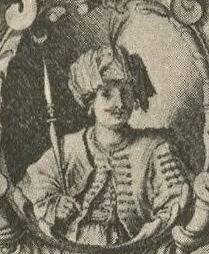Mohammed esh-Sheikh es-Seghir
| Mohammed esh-Sheikh es-Seghir | |||||
|---|---|---|---|---|---|
 Mohammed esh Sheikh es Seghir, by Adriaen Matham, 1640 | |||||
| Sultan of Morocco | |||||
| Reign | 1636 – 1655 | ||||
| Predecessor | Al Walid ben Zidan | ||||
| Successor | Ahmad al-Abbas | ||||
| Born | Unknown ? | ||||
| Died | 30 January 1655 | ||||
| Burial | 1655 Saadian Tombs | ||||
| Issue | Ahmad al-Abbas | ||||
| |||||
| Dynasty | Saadi | ||||
| Father | Zidan al-Nasir | ||||
| Religion | Sunni Islam | ||||
Mohammed esh Sheikh es Seghir (Arabic: محمد الشيخ الأصغر السعدي) (? – 30 January 1655) was the sultan of Morocco from (1636 – 1655) under the Saadi dynasty.
Life
His father was Zidan al-Nasir (r. 1603–1627), he was the son of a Spanish mother and he had two Spanish wives. He spoke good Spanish which may have led to him to continue the long-time services of royal advisor Moses Pallache, nephew of Samuel Pallache of the Pallache family.[1]
His portrait can be found in an engraving of Marrakesh by Adriaen Matham in 1640, made on the occasion of a visit by the ambassador of the Netherlands to the sultan.
Mohammed esh-Sheikh es-Seghir tried to concentrate the entire Moroccan foreign trade in Safi at the hands of the English, and to obtain warships from their king to prevent all trade with the south, but the sultan was afraid of breaking relations with the Dutch and the French.[2] In 1638, the Sultan sent his ambassador Muhammad bin Askar to England, who was carrying a letter to hasten King Charles I of England to send the required weapons and ammunition to Morocco and to suppress the English merchants who were selling weapons to the rebels. This was based on the treaty concluded between the two countries on September 20, 1637, which stipulated that no relationship should be established between the Kingdom of England and the sultan's enemies in Santa Cruz. Despite this, English merchants continued to smuggle weapons into the desert.[3][4]
See also
References
- ^ García-Arenal, Mercedes; Wiegers, Gerard (2007). A Man of Three Worlds: Samuel Pallache, a Moroccan Jew in Catholic and Protestant Europe. Johns Hopkins University Press. p. 117.
… he was the son of a Spanish mother and had two Spanish wives. Like Muley Zaydan, alSaghir spoke good Spanish
- ^ دوكاستر - س.أ. - السعديون م. 3 ص 358 (1935)
- ^ وثائق دوكاستر، س أ السعديون م 3 ص 523، 530 عام 1935.
- ^ السفراء والقناصلة بتطوان عبد العزيز بنعبد الله Archived 2016-03-07 at the Wayback Machine
| Preceded by | Sultan of Morocco 1636–1655 | Succeeded by |
- v
- t
- e
(788–974)
- Idris I (Idris ibn Abdallah)
- Idris II (Idris ibn Idris)
- Muhammad ibn Idris
- Ali I (Ali ibn Muhammad)
- Yahya I (Yahya ibn Muhammad)
- Yahya II (Yahya ibn Yahya)
- Ali II (Ali ibn Umar)
- Yahya III (Yahya ibn al-Qasim)
- Yahya IV (Yahya ibn Idris ibn Umar)
- Hasan I (al-Hasan ibn Muhammad)
- Al-Qasim ibn Ibrahim
- Abu'l-Aysh ibn al-Qasim
- Hasan II (al-Hasan ibn al-Qasim)
(1040–1147)
(1121–1269)
- Abd al-Mu'min
- Yusuf I (Abu Yaqub Yusuf)
- Yaqub al-Mansur
- Muhammad al-Nasir
- Yusuf II (Yusuf al-Mustansir)
- Abd al-Wahid I (Abd al-Wahid al-Makhluʿ)
- Abdallah al-ʿAdil
- Yahya al-Mu'tasim
- Idris al-Ma'mun
- Abd al-Wahid II
- Said al-Muʿtadid
(1244–1465)
- Abu Yahya ibn Abd al-Haqq
- Abu Yusuf Yaqub ibn Abd al-Haqq
- Abu Yaqub Yusuf an-Nasr
- Abu Thabit Amir
- Abu al-Rabi Sulayman
- Abu Sa'id Uthman II
- Abu al-Hasan Ali ibn Othman
- Abu Inan Faris
- Abu Zayyan Muhammad II
- Abu Bakr ibn Faris
- Ibrahim ibn Ali
- Tashfin ibn Ali
- Abd al-Aziz ibn Ali
- Muhammad III ibn Abd al-Aziz
- Ahmad ibn Ibrahim (al-Mustansir)
- Musa ibn Faris
- Muhammad ibn Ahmad (al-Wathiq)
- Ahmad ibn Ibrahim (al-Mustansir)
- Abd al-Aziz ibn Ahmad
- Abdallah ibn Ahmad
- Uthman ibn Ahmad
- Abd al-Haqq ibn Uthman
(1465–1471)
- Muhammad ibn Ali Amrani-Joutey
(1471–1549, 1554)
(1549–1659)
- Mohammed al-Shaykh
- Abdallah al-Ghalib
- Muhammad al-Mutawakkil
- Abd al-Malik I (Abu Marwan Abd al-Malik al-Ghazi)
- Ahmad al-Mansur
- Abu Faris Abdallah
- Abdallah al-Ghalib II
- Zidan al-Nasir
- Abd al-Malik II (Abu Marwan Abd al-Malik ibn Zidan)
- Al-Walid ibn Zidan
- Mohammed esh-Sheikh es-Seghir
- Ahmad al-Abbas
(1659–1663)
(1666–present)
- Al-Rashid ibn Ali
- Ismail ibn Ali
- Ahmad ibn Ismail
- Abd al-Malik ibn Ismail
- Abdallah ibn Ismail
- Ali ibn Ismail
- Muhammad II (Muhammad ibn Ismail)
- Al-Mustadi' ibn Ismail
- Zin al-Abidin ibn Ismail
- Muhammad III (Muhammad ibn Abdallah)
- Al-Yazid ibn Muhammad
- Hisham ibn Muhammad
- Suleiman ibn Muhammad
- Abd al-Rahman ibn Hisham
- Muhammad IV (Muhammad ibn Abd al-Rahman)
- Hassan I (Al-Hassan ibn Muhammad)
- Abd al-Aziz ibn al-Hassan
- Abd al-Hafid ibn al-Hassan
- Yusuf ibn al-Hassan
- Muhammad ibn Arafa
- Muhammad V (Muhammad ibn Yusuf)
- Hassan II (Hassan ibn Muhammad)
- Muhammad VI (Muhammad ibn al-Hassan)
  | This Moroccan biographical article is a stub. You can help Wikipedia by expanding it. |
- v
- t
- e
 | This biography of a member of an African royal house is a stub. You can help Wikipedia by expanding it. |
- v
- t
- e









